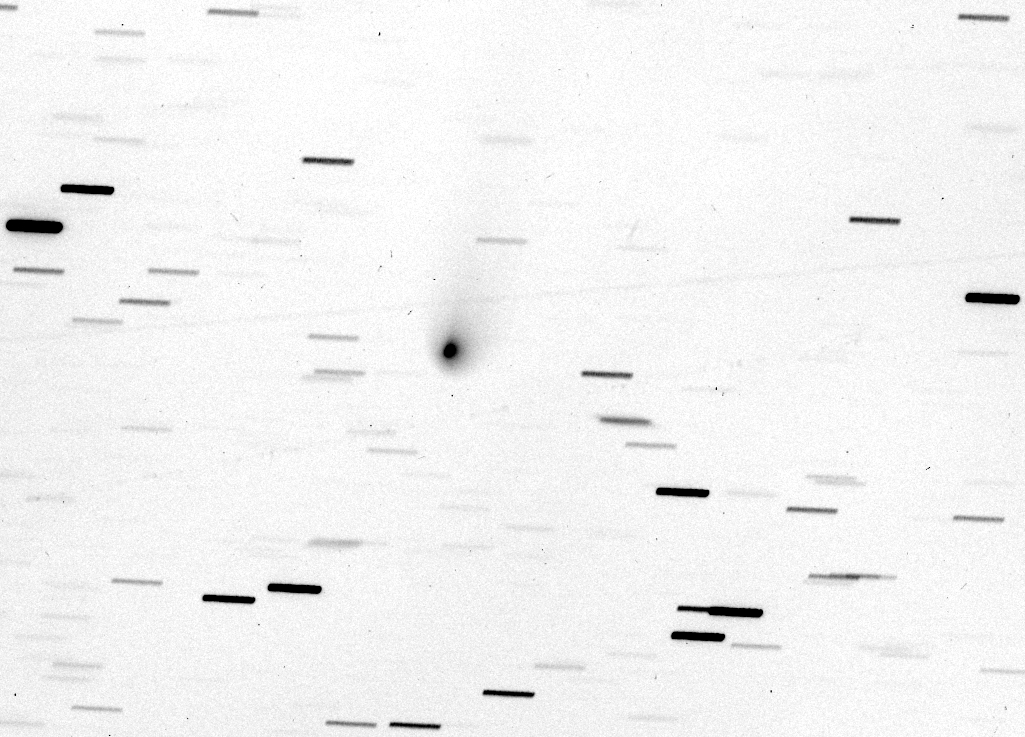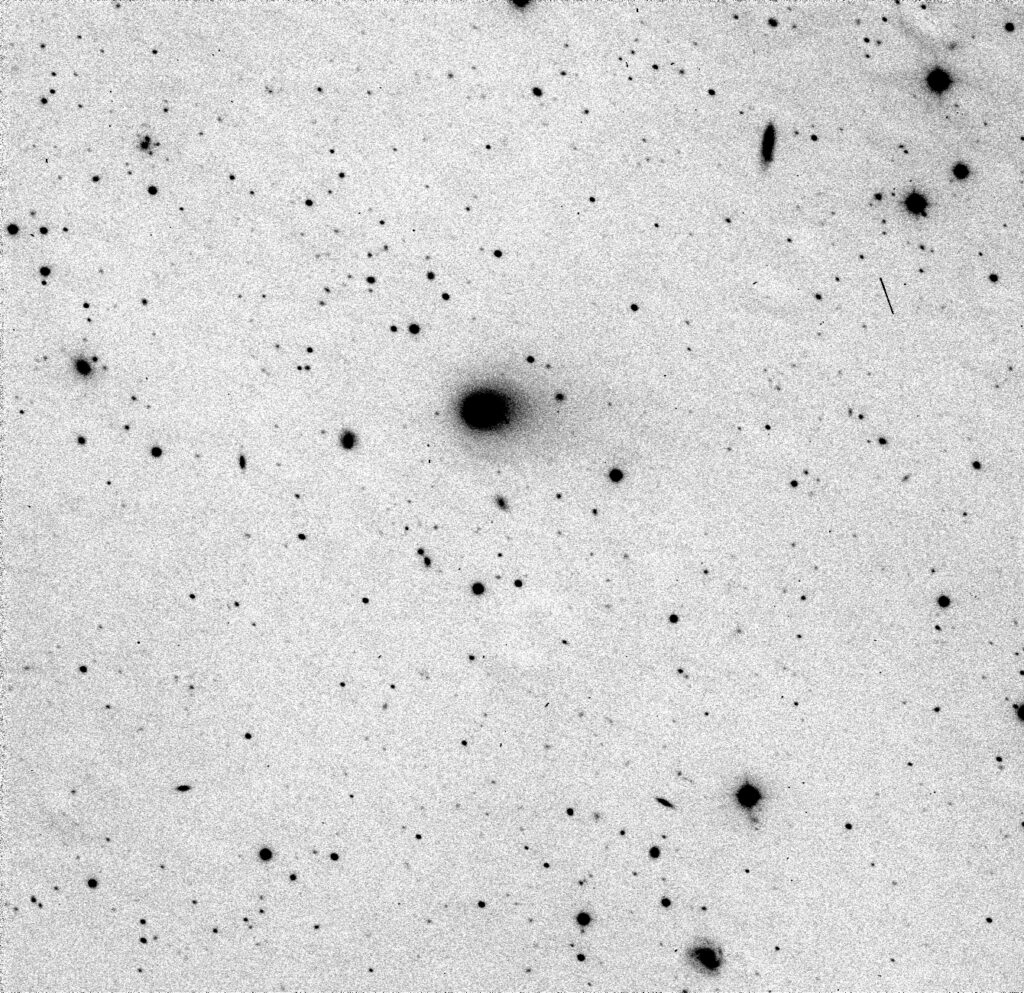A comet is a minor icy body of the Solar System that, as it passes close to the Sun, heats up and releases gas into the surrounding space, a process called degassing. This produces a visible atmosphere or coma, sometimes even one or more tails. Cometary nuclei are very dark solid bodies, mostly in very elliptical orbits around the Sun, have dimensions between 1 and 10 km and have a mixed composition of water ice and rock that leads to an average density of about 0.5-1.0 g/cm³. Compared to the planets of the Solar System, cometary nuclei are very small bodies. Usually, nuclei become active – that is, they expel gas and dust into space – when they are below the snow line which, in the Solar System, is about 2.8 AU from the Sun (about 420 million km). At this heliocentric distance, a cometary nucleus reaches a surface temperature of about -100 °C, the sublimation of water ice begins and the comet’s coma forms, with typical dimensions ranging from 100,000 to 1,000,000 km. The sublimation rate will increase until it reaches a maximum around the perihelion (point of the orbit closest to the Sun), then decrease when the nucleus moves away from our star. Getting even closer to the Sun, the interaction of the coma with the radiation and the solar wind forms, in the direction approximately opposite to the Sun, the dust tail and the ion (or plasma) tail of the comet, with lengths of about 10 and 100 million km respectively. The dust tail has a characteristic yellowish colour because it diffuses solar radiation, and the ion tail has a bluish or greenish colour depending on the molecular species responsible for the fluorescence emission. As can be seen, nuclei of modest size can create the largest, albeit rarefied, structures observable in the Solar System. This simple picture is not exhaustive: some comets are active well beyond 2.8 AU from the Sun because they are rich in super volatile elements. In addition to water ice, carbon monoxide (CO) and carbon dioxide (CO2) ice may be present in cometary nuclei as minority components. The latter has the property of sublimating at lower temperatures than water ice. The dioxide ice sublimates up to about 10 AU, while the monoxide ice reaches up to 25 AU, with a rate comparable to water ice at 2.8 AU.

The remote comet C/2017 B3 taken on September 15, 2020, with the “Cassini” telescope shows a coma and tail despite being over 6 AU from the Sun, well beyond the Solar System’s snow line.
Comet Interceptor (CI), is a mission of the European Space Agency (ESA), in collaboration with the Japanese JAXA and is currently in the planning phase (launch is scheduled for 2028). ESA has launched the Giotto and Rosetta missions to study Halley and 67P/Churyumov-Gerasimenko comets, but they were well-known and relatively evolved comets, with thick layers of dust on the surface that isolate the volatile materials inside. Compared to Giotto and Rosetta, CI presents some crucial innovations. In the first place, the mission’s objective will not be a periodic comet, but a dynamically new comet or DNC (Dynamically-New Comet), or – even better – a new interstellar comet similar to 2I/Borisov.
The target of the CI will be a comet that will come directly from the Oort cloud (or from interstellar space), without previous interaction with the Solar System’s planets: it will be an uncontaminated comet, with ice and surface volatiles that go back to the Solar System Genesys. These comets are usually identified shortly before the perihelion passage, without time to plan and launch a space mission. For this reason, the launch of CI will take place before the target identification: the mission will have as a provisional destination the Lagrange Point L2 of the Sun-Earth system, located about 1.5 million kilometres “behind” the Earth seen from the Sun. Here the probe will wait until the flyby with the first suitable DNC.
The mission will be redirected toward a known comet if no DNC is available. The Comet Interceptor mission is composed of three spacecraft. The three modules will travel together and separate only a few weeks before the comet flyby. Each module will be equipped with a scientific payload complementary to the others, to provide different perspectives of the nucleus and the coma gas, dust and plasma. Considering the parking in L2, CI will fly by with the target near 1 AU from the Sun and on the Ecliptic plane, so not all DNCs are suitable, it will strongly depend on the orbit. Presumably, the flyby will take place at high relative speeds (between 20 and 80 km/s), so the time available for the analysis of the comet will be limited, a bit like what happened with the Giotto mission during the historic flyby with the Halley comet, on March 13, 1986. Like Giotto, the probes will have shields to protect them from high-speed impacts with the coma dust particles.

The comet C/2020 T2 was imaged on 10 March 2021 by the “Cassini” telescope, just below the snow line and 255 million km from the Earth.
The OAS contribution to Comet Interceptor
In OAS, optical observations of non-periodic comets (potentially similar to future Comet Interceptor targets) are made using the “Cassini” telescope of the Loiano station. The observations support the Italian group of Comet Interceptors and are in synergy with spectroscopic observations conducted at the Galileo National Telescope (TNG). The primary purpose of OAS’s observations is to measure the dust emissions rate of remote comets and to study how comet activity evolves from 10 AU to 1 AU. CI will be designed to withstand a cometary activity such as Halley’s comet and it is essential to be able to know in advance how the activity of DNC will evolve. Hence the importance of observing comet activity during the transition from the sublimation of carbon monoxide and dioxide to water ice, i.e. to observe what happens to the comet as it crosses the snow line.
